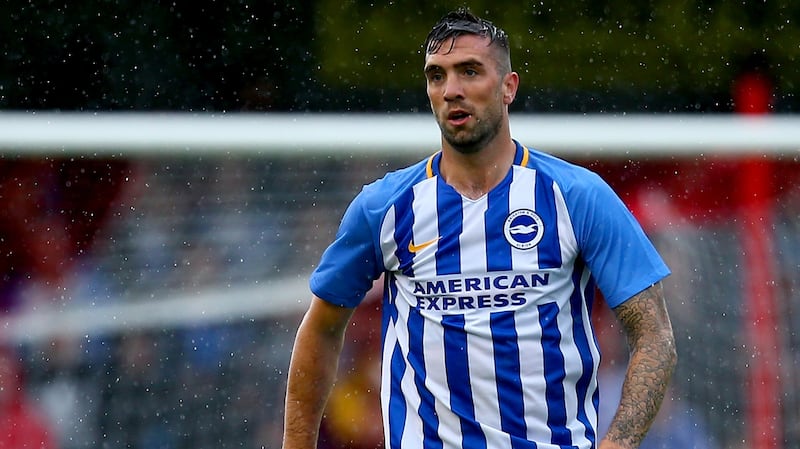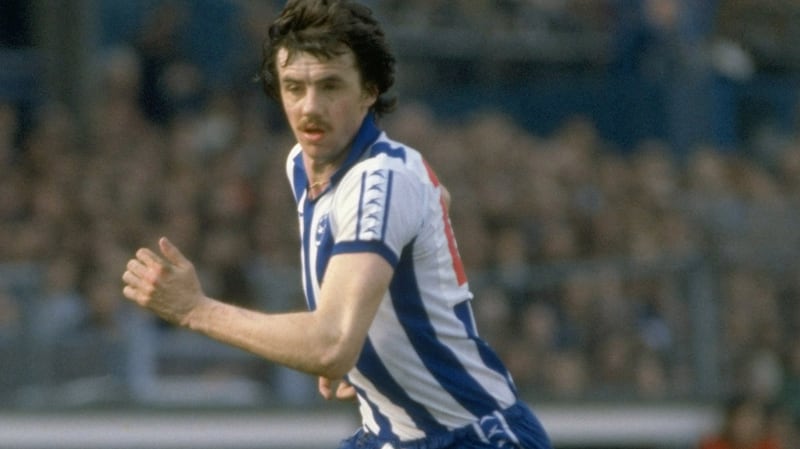There are places on the map of English football that pulsate when viewed through Irish eyes. Manchester, Liverpool, north London? Places where many of our greats have been their greats too, and where the Irish still flock to support their chosen teams.
And on it goes: Leeds, Birmingham, Sunderland . . . Who knows, we might be adding Preston in the not too distant future.
How long, though, before anyone rattling off such a list would mention Brighton? If, that is, they remember to mention Brighton at all?
Now might be the time to take notice. Brighton & Hove Albion are returning to the Premier League. They play Manchester City at the Amex Stadium on Saturday, under the management of Chris Hughton (53 senior caps between 1979 and 1991 and one of the Republic of Ireland's all-time greats) and with Shane Duffy (11 caps and counting) and former Under-21 international Richie Towell in the playing squad. The women's team is captained from left-back by another Irish international, Sophie Perry (30 caps).
These four are merely the tip of an iceberg. The truth is that you could have a very decent stab at putting together an all-time Irish XI drawn from those who have played for or managed Brighton that would be as good as most other combinations.
If you think I’m exaggerating, keep reading. (And consult the sidebar.)
This is a heritage that stretches back a long, long way. Charlie Webb was born into a Scottish military family at the Curragh Camp in 1886. He played 248 times for Brighton between 1909 and 1915 and went on to manage the club for an astonishing 28 years, beginning in 1919. (The gap between playing and managing was filled with the First World War. Webb fought on the Western Front and spent the last nine months of the conflict as a prisoner of war in Mainz.) He won three professional caps for Ireland and one as an amateur.
Just as intriguing as the playing heritage is the rich seam of Irishness running through the club’s fan base. The Irish community in Brighton flies under the radar compared to the likes of Kilburn or Liverpool, or even Crawley, with its annual Irish Festival, just 20 miles away.
And, sadly, mention Brighton and Ireland to most people and the association they will make is a lot darker than football. The IRA bomb that exploded at the Grand Hotel during the Conservative Party conference in the small hours of Friday 12 October, 1984, killed five people, though not its principal target, Margaret Thatcher.
Emigrant community
In the 70s and 80s, Cardinal Newman, a huge, mixed Catholic secondary school in the heart of Brighton, was packed with children from Irish families that had arrived in the town in the 1950s and 1960s in search of work and quality of life. The headmaster was a friend of Brian Clough. Before one match against Brighton, Clough brought his Forest team, then European champions, Martin O'Neill and all, to train on the school pitch.
Jack Dineen has seen this Brighton-Irish footballing heritage from both sides of the fence, as a fan and as a player, spending three years as a professional at his hometown club. Born in the town to parents from the north side of Cork City, he went to school at Cardinal Newman. Jack remembers a thriving emigrant community.
“All our parents knew one another. There was an Irish club near the sea front where everyone used to go.”
His was a sporting family. Jack’s paternal grandfather was one of the founding fathers of Fr Horgan’s Boxing Club back in Cork. His dad acted as physio for some of the Brighton youth teams. First-team players like Kieran O’Regan and the late Paul McCarthy became regular visitors to the house for Sunday roasts.

Both were players Jack, and Brighton fans in general, rated highly: “Paul was solid as a rock. He literally never had a bad game. Kieran was a great player too. He had real energy.”
Jack played three times for Ireland U-21s, including a match against England when he turned down Alan Shearer’s offer to swap shirts.
“He was at Southampton then and I knew him a bit already from various youth matches. I said ‘You’re okay, Al’. I think he was a little offended!”
The Irish connection to Brighton was very real back then.
“Yeah, with people like me around, lads from Northern Ireland, apprentices, some of the six-a-side games in training would be Ireland versus the rest. Pulling on the shirt for my hometown club, and pulling on the shirt for Ireland with my mam and dad and family there as the national anthem played, were two very special, proud moments.”
The Irish community itself, though, is not as evident now as it used to be. Brighton is a different kind of place now. Or, as Jack puts it, “the melting pot has well and truly melted”. The Amex on match day has become the place where he and old school friends meet and catch up.
One of those friends is James Grimes, whose parents came to Brighton from Co Longford. He lives and works in London now, but can still get from his front door to his seat at the Amex in less than an hour. Having followed Brighton for almost 50 years, he has seen several Irish players represent his hometown. So who was the greatest?
"Mark Lawrenson," he replies with barely any hesitation. "It was odd. He looked like a bag of bones. It was like Shaggy from Scooby Doo was out there playing for Brighton. He was lethargic almost. But what a player!"
Childhood hero
And the greatest day? For James, this was the 1983 FA Cup semi-final, a 2-1 win over Sheffield Wednesday in which another Irish international, Michael Robinson, scored.
Brighton went on to draw the final 2-2 with Manchester United. It was Robinson who knocked Kevin Moran off the ball in extra time of the final at Wembley to set up Scottish striker Gordon Smith for the chance to win the game, a moment immortalised in the television commentary line "And Smith must score".
He didn't, of course. Gary Bailey saved and a United squad featuring Moran, Frank Stapleton (who was to wind up his playing career at Brighton) and Ashley Grimes won the replay 4-0. As well as Robinson, Tony Grealish and Gary Howlett also played for Brighton in both games and Gerry Ryan was a substitute.
Michael Robinson was Jack Dineen’s childhood hero. He remembers glory nights at the old Goldstone Ground during that cup run with Robinson “full of running, strong, with a trick or two. He could cross a ball too and made it look easy, which it isn’t”.

Then there is the one that got away. Roy Keane was all set for a trial at Brighton as a teenager, arranged by Paul McCarthy, his old Rockmount team-mate. The trial was cancelled on the day before he was due to travel from Cork. Brighton had heard that Keane was too small to make it as a pro.
And one could extend the Brighton Irish connection even further by looking north: Gerry Armstrong, Sammy Nelson, Danny Wilson and Steve Penney are all ex-Seagulls.
To be fair, it hasn't always been a tale of careers made and glory gained. Liam Brady's prospects as a manger came to grief at Brighton. And in 2001, a pre-season friendly with Longford turned seriously nasty with several punch-ups and three sendings-off. Brighton's then manager Mickey Adams took his team from the pitch before half-time. The game was abandoned, along with the rest of the club's Irish tour.
But what of the present, and the Hughton effect in particular?
“Brighton fans appreciate his honesty and calmness in victory or defeat,” thinks James. “He has never tried to make the success about him or individual players. It’s about the whole team and the club. One or two managers in the recent past have been more flamboyant, but we’ve seen where that ends up.”
“The season ahead will be really tough. Personally, I’m taking the whole thing as a season’s holiday in the Premier League, long overdue. But I wouldn’t mind betting we cause a few upsets with a team that has at its core the same work ethic and feet on the ground as the manager.”
Jack Dineen feels a similar mixture of phlegmatic realism and tentative optimism. Little wonder. It has been a rocky ride for Brighton in recent years.
In 1997, they escaped being evicted from the Football League on the last day of the season with a late goal at Hereford United (who dropped out instead, never to return, and were wound up in 2014). The Goldstone Ground was sold to property developers and for a number of years the club’s home stadium was a converted athletics track. In 2013, 2014 and 2016, they made it to the play-offs for the Premier League, but couldn’t make it over the line. Finally, their time has come.
“After all that the club and the fans have been through,” says Jack, “we’ll enjoy every ball kicked in anger in the Premier League.”
The whole of Irish football, you feel, should be wishing them well.
A quick guide to some of the Boys in Green who’ve also been boys in blue.
John Byrne – Striker. 23 caps and four goals for Ireland between 1985 and 1993. Made 51 appearances for Brighton in the 1990-91 season, scoring 14 goals. Returned for a loan spell from Bolton in 1993 and rejoined in the 1996-96 season, scoring six more goals for the club.
Tony Grealish – Midfielder. 45 caps for Ireland with 17 as captain. Played 100 times for Brighton in the 1980s. Passed away in 2013.
Gary Howlett – Midfielder from Dublin. One cap for the Irish senior team. Crossed for Gordon Smith to score in the 1983 FA Cup Final.
Roy Keane – Nearly. See main article.
Joe Kinnear – Defender who played at Tottenham for most of his career. Played his final season as a professional with Brighton. 26 caps for Ireland.
Mark Lawrenson – Defender. Four seasons at Brighton, including 1978-79 when they won promotion to the old First Division, before being sold to Liverpool in 1981. 39 caps for Ireland.
Paul McCarthy – Under 21 international from Cork who played for Brighton over 180 times. Died earlier this year at the age of 45.
Kieran O'Regan – Another Corkman, signed from Tramore Athletic. Won four caps for Ireland during four seasons at Brighton in the 1980s.
Michael Robinson – 24 caps and four goals for his country. Three seasons at Brighton before following Lawrenson to Liverpool in 1983. Now a football pundit in Spain where be played for Osasuna.
Gerry Ryan – Ex-Bohemians winger. 18 caps for Ireland and seven seasons at Brighton between 1978 and 1985. Assistant manager during Liam Brady's time.
Pat Saward – Born in Cobh. Managed Brighton between 1970 and 1973 following a playing career with Millwall, Aston Villa and Huddersfield. 18 caps for Ireland as a midfielder. Passed away in 2002.











